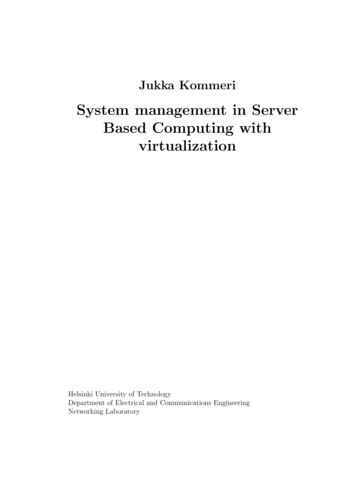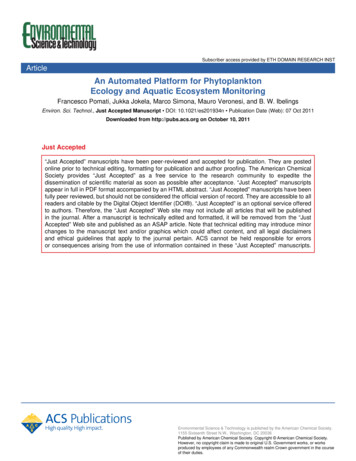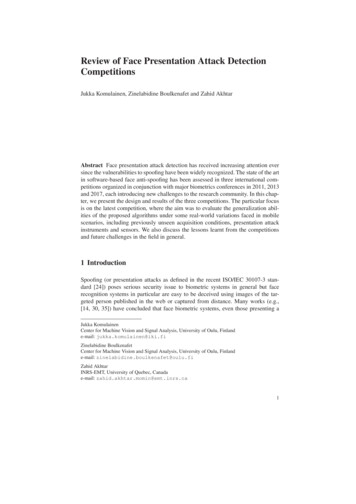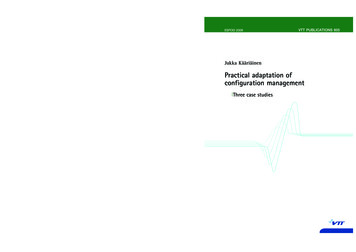
Transcription
Jukka KommeriSystem management in ServerBased Computing withvirtualizationHelsinki University of TechnologyDepartment of Electrical and Communications EngineeringNetworking Laboratory
iiHELSINKI UNIVERSITYOF ip:Supervisor:Instructor:ABSTRACT OF THEMASTER’S THESISJukka KommeriSystem management in Server Based Computing with virtualization2nd October, 2008Number of pages: 51Electrical and Communications engineeringS-38Professor Jörg OttTapio Niemi, PhD, Helsinki Institute of PhysicsThe purpose of this thesis is to study the use of virtualization in server- based computing services. The results of this study were used to produce a prototype for theFinnish National Technology Agency (TEKES) funded NETGATE 2 research project.The prototype makes the installation of remote machines automatic and provides away to distribute centrally managed services.The installation and configuration of different services need a lot of work and knowledge. Many times this is repetitive as the services need to be installed in severallocations and repeatedly. In a large organization this forms a significant expense.On the other hand small organizations cannot always afford an administrator andthe administrating work falls to the person most capable. This results in insecureand unreliable installations. For these companies it would be beneficial to have theservices ready to use without any expertise in the matter.We solved the above problem by creating a system to distribute centrally managedservices. This was done by enclosing generic services with their operating systems intotransportable system images. These images can then be run on top of a virtualizationplatform as virtual machines. Images can be centrally created and maintained andthen reused in various locations. Virtualization provides the images with a standardplatform on which they can be placed.The prototype uses the Xen virtualization and the Debian package management system to manage a collection of virtual machine images and distribute them accordingto the needs of the remote machines. The system gives the tools for automateddeployment of the base operating system and virtualization tools over Internet. Italso contains the tools for automated updates. In addition the system decreases theamount of administrative work and removes the need for expertise from the remotelocation.Our prototype makes installation and management of large systems possible with lesswork than conventional systems. The system has been tested in several locationssuch the CERN library. The Debian package management system has proven to bean easy way to start up virtualized services and Xen has been good choice for thevirtualization.Keywords: SBC, virtualization, Xen, LTSP
iiiTEKNILLINEN KORKEAKOULUDIPLOMITYÖN TIIVISTELMÄTekijä:Tyon nimi:Jukka KommeriPalvelun hallinta palvelin keskeisessä ympäristössäkäyttäen virtualisointiaPäivämäärä: 2. lokakuuta 2008Sivuja: 51Osasto:Sähkö ja tietoliikennetekniikan osastoProfessuuri:S-38Työn valvoja: Professori Jörg OttTyön ohjaaja: Tapio Niemi, FT, Helsinki Institute of PhysicsTämän diplomityön tarkoitus on tutkia virtualisoinnin käyttöä palvelin-pohjaisenlaskennan palveluissa. Tutkimuksen tuloksia hyödynnettiin luotaessa prototyyppiä TEKES-rahoitteiseen NETGATE-2 tutkimusprojektiin. Prototyyppi automatisoi etäkoneiden asentamista ja mahdollistaa keskitetysti ylläpidettyjen palvelujenjakelun.Erilaisten palveluiden asentaminen ja konfigurointi edellyttää paljon työtä jatietämystä. Usein tämä työ on toisteista, kun samaa palvelua asennetaan useaankohteeseen ja useaan otteeseen. Isossa organisaatiossa toisteisuudesta voi syntyäsuurikin kustannuserä. Pienemmissä organisaatioissa eivät resurssit puolestaanaina riitä omaan ylläpitoon tai työtä tekemään valitulla ei välttämättä olesopivaa koulutusta. Tästä on todennäköisesti seurauksena turvaton ja epäluotettavajärjestelmä. Molemmissa tapauksissa olisi hyödyllistä voida käyttää keskitettyäpalvelua joko omalta tai ulkopuoliselta ylläpidolta.Ratkaisimme ongelman kehittämällä järjestelmän, joka jakaa keskitetysti hallittuja palveluita. Tämä on toteutettu sulkemalla palvelut ja niiden käyttöjärjestelmätsiirrettäviin järjestelmälevykuviin. Levykuvia voidaan ajaa virtualisointi-alustanpäällä virtuaalikoneina. Keskitetysti luotuja ja ylläpidettyjä levykuvia voidaanuudelleen käyttää monessa kohteessa. Virtualisoinnilla tarjotaan levykuvissa olevillekäyttöjärjestelmille vakio-alusta, jolla toimia ja näin taata toimivuus.Prototyyppi käyttää Xen-virtualisointia ja Debianin koelman hallintaan ja jakamiseen etäkoneisiin. Järjestelmä mahdollistaa peruskäyttöjärjestelmän, virtualisointityökalujen ja automatisoidunpäivtysjärjestelmän etäasennuksen.Prototyyppimme tekee suurten järjestelmien asentamisen ja hallinnan kevyemmäksikuin perinteiset menetelmät. Järjestelmää on testattu useassa kohteessa kutenCERN:in kirjastossa. Debianin paketinhallintajärjestelmä on osoittautunut helpoksi tavaksi käynnistää virtualisoituja palveluita ja Xen on puolestaan ollut tehokasvirtualisointialusta.Avainsanat: SBC, virtualisointi, xen, LTSP
AcknowledgementsThis thesis was done for the Helsinki Institute of Physics Technology Program atCern in Switzerland.I would like to thank the Helsinki Institute of Physics and my boss MSc MiikaTuisku for making my stay in the scenic region of Switzerland possible. Also Iwould like to thank my instructor PhD Tapio Niemi, who kicked me forward andcoloured many versions of my thesis. Thanks also to my Professor Jörg Ott forsupervising my thesis and giving valuable comments.Finally, I would like to thank my family for all encouragement and support givenduring my studies.CERN Geneva, 2nd October, 2008Jukka Kommeriiv
Table of ContentsContentsviList of FiguresviiList of TablesviiiAbbreviationsixAbbreviationsix1 Introduction12 Problem Definition2.1 Netgate 2 . . . . . . . . . . . . . . . . . . . . . . . . . . . . . . .2.2 Research Problem . . . . . . . . . . . . . . . . . . . . . . . . . . .2.3 CERN Library Use-case . . . . . . . . . . . . . . . . . . . . . . .44563 Server-Based Computing3.1 Thin Client Protocols . . . . . . . . . . . . . . . . .3.1.1 ICA - Independent Computing Architecture3.1.2 RDP - Remote Desktop Protocol . . . . . .3.1.3 VNC - Virtual Network Computing . . . . .3.1.4 X Window System . . . . . . . . . . . . . .3.1.5 NX - New X . . . . . . . . . . . . . . . . . .3.2 Linux Terminal Server Project - LTSP . . . . . . .3.3 Summary . . . . . . . . . . . . . . . . . . . . . . .789910101112134 Virtualization and System Management4.1 Overview . . . . . . . . . . . . . . . . . .4.2 Benefits . . . . . . . . . . . . . . . . . .4.3 Methodology . . . . . . . . . . . . . . .4.3.1 Paravirtualization . . . . . . . . .4.3.2 Software Virtualization . . . . . .141516161718v.
4.44.54.64.74.84.94.3.3 Hardware Support . . .Xen . . . . . . . . . . . . . . .VMware . . . . . . . . . . . . .KVM - Kernel Virtual MachineLinux VServer . . . . . . . . . .System Management . . . . . .4.8.1 Planetlab . . . . . . . .4.8.2 Smart Domains . . . . .Summary . . . . . . . . . . . .1819202022222224255 Solution5.1 Debian Package Management System5.2 SBC Service . . . . . . . . . . . . . .5.3 System Components . . . . . . . . .5.3.1 Client Installation Media . . .5.3.2 Image Server . . . . . . . . .5.3.3 Image . . . . . . . . . . . . .5.3.4 Configuration Server . . . . .5.3.5 Package Manager . . . . . . .5.4 Operation of the System . . . . . . .5.5 CERN Library Pilot . . . . . . . . .26272930303131323233346 Evaluation6.1 Key Features of Prototype . . .6.2 Usability . . . . . . . . . . . . .6.3 Performance . . . . . . . . . . .6.3.1 Distribution of Services .6.3.2 Security and Reliability6.3.3 Virtualization . . . . . .6.4 Distributing Virtualized SBC .6.5 CERN Library Use-case . . . .6.5.1 Performance . . . . . . .6.5.2 Terminal Devices . . . .6.5.3 Open Source . . . . . . .6.6 Discussion . . . . . . . . . . . .37373838384142434444464747.7 Conclusions49A Remote management system setup manual52B CERN library thin client system63Bibliography67vi
List of Figures1.1Server-based computing . . . . . . . . . . . . . . . . . . . . . . .13.13.23.3Thin client and server roles . . . . . . . . . . . . . . . . . . . . .Simple X window system architecture . . . . . . . . . . . . . . . .NX architecture (Courtesy of [36]) . . . . . . . . . . . . . . . . . .811124.14.24.34.44.5Traditional virtualization architecture . . . . . . . . . .x86 ring model (Courtesy of [2]) . . . . . . . . . . . . .Xen hypervisor architecture (Courtesy of [28]) . . . . .Kernel Virtual Machine architecture (Courtesy of [22])Node management interface with the overall picture oftribution . . . . . . . . . . . . . . . . . . . . . . . . . . . . . . . . . .node. . . . . . . . . . .dis. . .151720215.15.25.35.4Distribution system overview .Virtualized SBC environmentWorkflow of the system . . . .CERN library pilot . . . . . .273034356.16.2Network traffic between the thin client and the server in Bytes/second using X Window system . . . . . . . . . . . . . . . . . . . . .Thin client used in CERN library (Courtesy of Gadget Computer)42467.1Future vision of server-based computing . . . . . . . . . . . . . .50B.1 The network of thin client system . . . . . . . . . . . . . . . . . .64.vii.23
List of Tables6.16.26.3SCP transfer speeds to VMs in MB/s . . . . . . . . . . . . . . . .Local transfer speeds in VMs in MB/s . . . . . . . . . . . . . . .Workstation (WS) set up times . . . . . . . . . . . . . . . . . . .viii394045
AbbreviationsABIApplication Binary InterfaceAPTAdvanced Packaging ToolCERNl’Organisation Europà c enne pour la Recherche Nuclà c aireFSFile SystemGDIGraphics Device InterfaceGUIGraphical User InterfaceHIPHelsinki Institute of PhysicsHTTPHypertext Transfer ProtocolHTTPS Hypertext Transfer Protocol SecureHWHardwareICAIndependent Computing ArchitectureKVMKernel Virtual MachineLANLocal Area NetworkLTSPLinux Terminal Server ProjectMyPLC My Planet Lab CentralNetgate Network Identity, Grid Service Access and Telecom enabled provisionNXNew XOSOperating SystemPCPersonal ComputerPDAPersonal Digital AssistantPXEPreboot Execution EnvironmentRFBRemote Frame Bufferix
RDPRemote Desktop ProtocolRMIRemote Method InvocationSBCServer-Based ComputingSCPSecure CopySSHSecure ShellTEKES Teknologian kehittämiskeskus (Finnish Technology Agency)TLSTransport Layer SecurityUSBUniversal Serial BusVMMVirtual Machine MonitorVNCVirtual Network ComputingWANWide Area NetworkWSWorkstationx
Chapter 1IntroductionServer-based computing (SBC) is an architecture where all the applications areinstalled, managed and executed on the server [5]. The computers of the users areconsidered as thin clients that exchange keyboard, mouse and screen informationwith the server. In pure SBC no actual programs are executed on the clientmachine. In the simplest case the client machine only runs the software requiredto transmit the user input and display the graphics.Figure 1.1: Server-based computing1
CHAPTER 1. INTRODUCTION2SBC itself has been around for many decades [44]. It has been a good solutionfor many cases but not a complete solution due to its dependency on networkspeed and computing power on the server side. Today the computing power isquite cheap and the networks are getting faster. Now SBC can be considered asan actual alternative for the personal computer (PC).SBC systems are easier to administer than PC-based systems because everythingis on one machine, the server [33]. Adding new terminals requires no installationwork as the client side devices are stateless. The hardware requirements for clientside devices are minimal. Basically old PCs with network cards are enough. Thecentralization also increases the overall security since only administrators areallowed to configure the system and install new components.There are several cases where big companies have adopted SBC technology. Forexample, in 2005 the Finnish Weather Forecasting Institute, Ilmatieteen laitos,announced to replace half of its desktops with thin clients. The University ofTampere has been using SBC for many years. There are several commercialSBC solutions such as the Sun Microsystems’ Sun Ray [6], HP’s server-basedcomputing solution [20] and a newcomer, Panologic 1 , as well as non commercialones such as LTSP 2 , K12LTSP 3 . According to Gartner’s studies [25] the thinclient market has increased 38% in the year 2006 which is according to them thehighest since the year 2000.One problem is that one SBC server can only serve a limited number of usersand its setup requires a lot of knowledge. In a big organization more than oneserver is needed. The bigger the organization is, the more work is required tomaintain the servers. To make it easier to handle multiple servers and reduce theend point administration, a central service distributor is needed: The server forservers that can be used to set up the SBC system in geographically dispersedsites and make the administration work more scalable.This thesis studies the use of virtualization and remote installation systems todistribute and manage services like SBC on remote machines. Virtualizationprovides a standard abstraction on top of which different services can be installed.With virtualization it is possible to put the same service on top of org3http://www.K12LTSP.org2
CHAPTER 1. INTRODUCTION3physical hardware and replicate to various locations.The thesis is structured as follows: In Chapter 2 we will look into different SBCtechnologies and define what SBC is and go through different implementations.After that, some virtualization and distributed system management technologieswill be covered. Following these related work chapters, the actual solution andprototype will be explained in Chapter 5. Its properties will be further analyzedin the following evaluation chapter. Finally, we will summarize the thesis withthe conclusion chapter.
Chapter 2Problem DefinitionIn this chapter we take a look at the Netgate 2 project and the research problemof this thesis. The study was conducted at the Helsinki Institute of Physics (HIP)technology program premises at CERN. A working pilot of the Netgate 2 projectis based on the solution of this thesis.2.1Netgate 2Netgate 2 1 is a research project funded by the Finnish National TechnologyAgency (TEKES) and Finnish industrial partners. The project is carried outand coordinated by Helsinki Institute of Physics in cooperation with TechnologyBusiness Research Center of Lappeenranta Technical University and the Department of Computer Sciences of the University of Tampere.The purpose of the project is to study grid technologies and find ways for theiradoption in Finnish industry. The project has three focus areas: security, serverbased computing, and grid business research. This thesis is a part of NETGATE2 and concentrates on the server-based computing.The server-based computing part of the project studies how to simplify the installation and management of remote systems: Making it possible for a nontechnicalperson to set up complicated services in his premises and also relieve him fromthe administration. This decreases the overall administration costs and ts/finnish/index.html#netgate-II4
CHAPTER 2. PROBLEM DEFINITION5the quality of administration for the end systems, i.e. ,the new installations aremore robust and secure.2.2Research ProblemInstalling servers and services assume a lot of understanding on the subject. Inmany cases the administrator is not fully qualified to do the installation but isselected for the task since he has the best knowledge about the subject [42]. Thiscan lead to unstable and insecure systems. To be sure that the system worksreliably it needs to be installed and administered by professionals. A problem isthat the usage of professionals or having your own administration is expensive.A out of the box solution is needed to make the services available in workingenvironments that lack the required skills: A solution that makes the outsourcing of administration possible. A solution that makes possible the distribution of services such as SBC,firewalls, web servers, file servers, etc. These services would be configured and tested by professionals before introduction.Tested services can be reused in several locations reducing the total amount ofadministration work. Clients can pick the set of services that they need fortheir environment and then just start their servers. The servers download all therequired services from the central repository and launch them automatically.The objective of this thesis is to study the SBC technologies and create a systemthat makes the distribution of SBC services less exhausting for the administration.We study the use of virtualization and automated installation for this problemand implement a prototype system that address the problem using only opensource components. The suitability of this prototype will be tested at the CERNlibrary.
CHAPTER 2. PROBLEM DEFINITION2.36CERN Library Use-caseCERN is the world’s largest particle physics laboratory 1 . It is situated on theborder of France and Switzerland just next to Geneva. It employs nearly 3000employees and hosts some 6500 visiting scientists yearly. The mission of theCERN library is to acquire and manage information resources in all fields ofrelevance to the organization and make them easily accessible.The CERN library provides its users with public terminals. These machines aremainly used to browse the Internet or to write documents. Currently desktopcomputers are used. They have Windows XP installed and connect to the CERNWindows domain. The installation of one of these machines takes about an hourand requires the involvement of the librarians. From the authors experience thisprocedure has to be repeated regularly, otherwise the machines become slower.Maintaining computers is not part of the core knowledge of the librarians and itinterferes with their normal responsibilities.The library is a good place to pilot the solution of this thesis. Replacing publicterminals of the CERN library with a thin client system has many benefits. Thinclients are silent and easy to maintain. Thin clients do not need any installationas they work out of the box. They just need to be put into their place, connectedto network and powered on. It takes about a minute for a thin client to boot andafter that it is ready to be used. The installation of the server takes more timebut with our system it can also be done automatically. All system componentsare open source, which gives us freedom to make more customized solutions thatfit better to the actual need.Thin clients and remotely managed server almost completely relieve the librariansfrom the administration of their public terminals. New thin clients can be addedjust by appending them to the same network as the others and by poweringthem up. Thin clients have a much longer life span than normal PCs, which inpart reduces the administration work. The replacement of the desktop PCs withcompletely silent thin clients makes the library sound like a library.1http://public.web.cern.ch/public
Chapter 3Server-Based ComputingLocal area networks (LAN) and wide area networks (WAN) make it possible tocentralize services. Instead of having all files and programs on local computers,as in the era of single user personal computers (PC), they can now be located oncentral servers and made reachable by others.Centralization is not only limited to storage services but it can also be used to runprograms. Due to the development of the networks and the exponential growthof processing power, the servers can now serve an increasing number of clientapplications. The benefits of this transition from local execution to centralizedone is decreased administration work and increased system security. The samedata can be accessed from several locations which gives more freedom for choosingthe place to work at and does not make the loss of personal machine so critical.The server-based computing system resembles the old mainframe systems thatwere used in the early times of computers. The difference being that now theservers are a lot smaller and offer users more usable user interfaces [37]. The ideabehind server-based computing is to move computation from PCs to centralizedcomputing resources. The only things, the PC does, are: Maintain connection to the server. Display graphics. Transmit information from peripherals such as keyboard, mouse or USBdevice.Thin client [5] is the client side device in the server-based computing. Almost7
CHAPTER 3. SERVER-BASED COMPUTING8Figure 3.1: Thin client and server rolesany PC can be used as a thin client. The requirements for thin clients are lowsince most or all of the computation is done elsewhere. Thin clients do not needhard drives, powerful processors or powerful graphics cards. Having less powerful components means less energy consumption and less heat production. Theecological footprint of the thin client in the SBC system is about half comparedto that of the PC[4]. The life cycle of the old and obsolete PC can be extendedusing it as the thin client. The requirements for a thin client vary on how muchof the software is executed on remote servers [17]. In pure SBC all the programsare run on the remote server. It is also possible to enhance the user experienceby running some of the programs on the client side.3.1Thin Client ProtocolsThere are several commercial products and open source projects that implementserver-based computing. Most of them have their own protocols for transmitting information with optimized algorithms to meet the requirements of differentnetworks and purposes.Thin client protocols balance between the load on the network and the load onthe end point machines: Usage of higher level graphics decreases the need totransmit data over the network but it requires more computation to form theimage from the high level graphic primitive commands. The usage of raw pixel
CHAPTER 3. SERVER-BASED COMPUTING9encoding causes more network traffic but reduces the computation on the clientside. The need to support the higher level graphics instead makes the client sidemore difficult to implement. Some protocols also adapt to the network traffic bysending updates less frequently, using caches, and compression [52, 26]. Therehas been a lot of development in the field of thin client protocols. Every newversion brings performance improvements and features. This and the proprietarynature of some protocols make the comparison of the protocols difficult withoutempirical studies. In the following sub-sections we will introduce a few popularprotocols that are used to provide server based computing.3.1.1ICA - Independent Computing ArchitectureThe independent computing architecture (ICA) [23] is a proprietary protocolowned by Citrix. Citrix is one of SBC pioneers and offers multiple commercialsolutions for both Windows and UNIX platforms. The SBC of Citrix is basedon the ICA protocol though they also offer web-based solutions [39]. ICA is alightweight protocol that can be used in low bandwidth networks such as modemconnections. It can be used to share both Windows and Unix-based operatingsystems. A low level of network traffic is achieved by using higher level graphicsprimitives and compression of network traffic. ICA also allows the client to cachebitmaps which decreases the network traffic even more [52].3.1.2RDP - Remote Desktop ProtocolThe remote desktop protocol (RDP) [3] is a proprietary protocol owned by Microsoft. RDP is an extension to the ITU-T T.120 application sharing protocolfamily. It is used to connect to Windows Terminal Services running on WindowsServers. RDP sessions can be configured to meet various needs. It supportsdifferent levels of encryption. The traffic between the client and server can besecured with the transport layer security (TLS) [32] and compression is also supported. RDP uses higher level graphics. The server sends clients rendering datathat the client uses to make API calls to the graphics device interface (GDI).RDP also supports roaming disconnect which means that the session stays alivethough the connection dies [31].
CHAPTER 3. SERVER-BASED COMPUTING10RDP clients are made for Windows platforms. There are also open source RDPclients such as Rdesktop 1 and open source RDP servers such as Xrdp 2 .3.1.3VNC - Virtual Network ComputingVNC is an open source thin client protocol. It is based on the remote framebuffer (RFB). RFB is a thin client protocol that works on the frame buffer levelmaking it applicable to all windowing systems and applications. VNC clientsare stateless, which makes them tolerant to network disruptions. Both VNC andRFB have originally been developed at Olivetti & Oracle Research Laboratory[38]. VNC represents the 2D graphics and raw graphics end of the protocols.Clients retrieve pixel information from the server. This makes the clients easierto implement and they do not need a heavy system such as the X WindowSystem to work. Therefore, VNC can be used in many light devices such asmobile phones and personal digital assistants [52]. The original VNC protocoldid not support compression or encryption but they have been added to somederived products such as TightVNC 3 . Compression decreases the latencies ofVNC in low bandwidth networks [24].3.1.4X Window SystemThe X Window System [34, 43] is the base for graphical user interfaces (GUI)in many Unix compatible operating systems. It implements the client servermodel. Applications are clients that connect to the server that handles inputfrom keyboard and mouse and output to monitor. Clients can be on the samecomputer as the server or on a remote one. Both client and server use X protocolfor their communication.Figure 3.2 illustrates how the X server, that runs on a workstation, is connectedto two X clients, that are on two separate remote machines, and also to two localX clients.The X window system is designed for local area networks. Though it uses e.net3http://www.tightvnc.com2
CHAPTER 3. SERVER-BASED COMPUTING11Figure 3.2: Simple X window system architecturelevel graphics, it sends updates more frequently than others and does not use anycompression, which makes it one of the heaviest protocol on the network. Theseproperties also make it the best quality protocol [52].3.1.5NX - New XNew X (NX) [36] is a protocol that enhances the basic X Window System makingit more usable in wide area networks. It acts as a buffer between the client andthe server of the X Window System. It can store the session information onthe remote machine making the X Window System more resilient to networkerrors. NX provides an encrypted and compressed link between the client andthe server machines. The protocol can also be adjusted to meet different networkconnections by suppressing the updates of the X Window System. Figure 3.3illustrates the architecture of the NX protocol.
CHAPTER 3. SERVER-BASED COMPUTING12Figure 3.3: NX architecture (Courtesy of [36])3.2Linux Terminal Server Project - LTSPThe Linux Terminal Server Project was founded in 1999 and has since thenbeen included in various Linux distributions. It has also been the base for thefoundation of a new Linux distributions such as K12LTSP 4 . At the time ofwriting of this thesis LTSP is in version 5.0 with the codename MueKow 5 . LTSPis an open source project that combines many other open source projects intoa comprehensive SBC solution. It offers various ways to connect thin and fatclients to the Linux server from different networks. The main usage of LTSP isto connect thin clients in the local area network to the central server using theX Window system.In LTSP, one does not need to install any operating systems to the workstations.They are booted with small Linux that is loaded either by PXE boot or from localmedia such as floppy, CD-Rom or USB stick. No hard disks are used at the clientside, which makes it possible to boot a desktop machine with an operating systemas a thin client without any harm to the existing system. All tools required formanaging the thin client and its graphical sessions are loaded from a networkdrive using the network file system (NFS) or the network block device w/Ltsp/MueKow
CHAPTER 3. SERVER-BASED COMPUTING13The thin client only runs X server and connects to a session manager on theserver in the LAN [30].3.3SummaryServer-based computing is an architecture in which most of the programs and personal files are executed and stored centrally. Centralization makes the resourcesaccessible from various locations and with different devices providing users withflexibility.The server and client communicate using a middleware. The middlewar
way to distribute centrally managed services. The installation and con guration of di erent services need a lot of work and knowl-edge. Many times this is repetitive as the services need to be installed in several locations and repeatedly. In a large organization this forms a signi cant expense.




